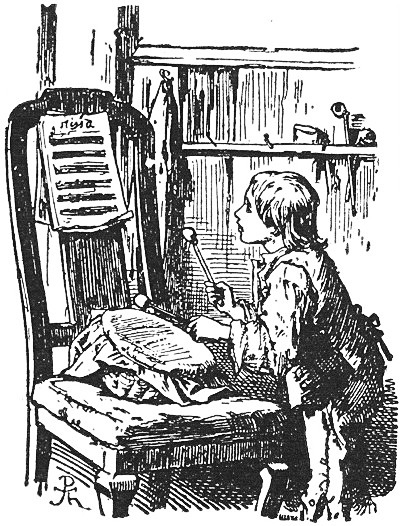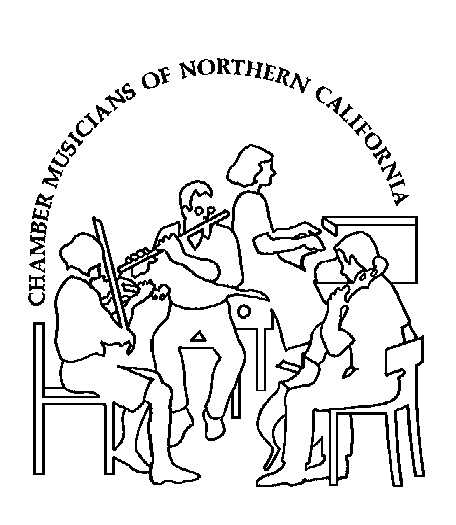Chamber Musicians of Northern California
Providing opportunities for musicians
to play and enjoy chamber music.
Find out about CMNC's Aims and Purposes
Take a look at CMNC's Library!
Adventures in the Rhythm Sectionby Elizabeth Morrison
|
When I moved to Redwood City two years ago, I called conductor Eric Kujawsky to ask if I could join the Redwood Symphony, my local community orchestra. He said he had a full complement of cellos, and I would have to wait until there was an opening. Then he added if I wanted, that I could come and “help out” in the percussion section.
The percussion section! I could hardly believe my ears. On the one hand, it was a little insulting—not to me, of course, but to the percussionists. How would they feel about having an ignorant cellist tossed their way? If you had an extra flute, would you send her over to “help out” in the violins? Did Eric imagine you just go back there and hit things?
On the other hand, I was intrigued. Like many cellists, I secretly pride myself on my rhythmic sense. Since composers in their wisdom have given us fewer notes to play than violins or violas, we often appoint ourselves Beat Police in a quartet. After years of playing those repeated 8th notes that coaches are always saying are like timpani strokes, wouldn't I be rather good at percussion? And wouldn't I learn things about rhythm that would help me play chamber music? The latter, at least, turned out to be true.
At the first rehearsal I presented myself to the bemused percussionists, who finally decided I could try playing triangle in Scheherazade. One of them lent me his triangle and unrolled a case with six different sticks. At that moment I realized this wasn't my kindergarten Rhythm Band. My mentor patiently showed me the difference between a trill and a tremolo and explained that you have to strike the triangle in the same place to get a consistent sound (and that it matters very much where you choose.) Finally, seeing the true depth of my ignorance, he showed me how to hang the triangle from the stand.
I couldn't wait to go home and practice. I put on a recording and found I was hearing the familiar piece in a new way. If you think about it, and I did, Scheherazade is mainly a vehicle for the triangle. Okay, maybe not quite, but at least you could say that Rimsky-Korsakov uses the triangle to highlight emotional moments, moments of heightened exoticism.
So here was my first lesson to take back to chamber music: beats have color. I wasn't just keeping the beat, I was keeping the beat in a specific way, on the triangle! A great orchestrator like R-K was able to give each beat its own distinct character, defined by the colors he found in the percussion instruments. I resolved that in chamber music I would try and somehow use the palette available on my cello to give each beat not just the right timing but the right emotional feeling as well.
I soon found that some things looked quite different from my new position. I got more of a sense of the piece as a whole from the percussion section than I'd ever gotten as a cellist. Strings play almost continuously, but percussionists have long rests, and they bring scores and follow them carefully. It was fascinating to find out what the clarinets were doing, when the brass came in, how the triangle part fit with the trombones. Next chamber music lesson: try to get out of my own part and study the score. Something else might just be going on!
Listening to Eric rehearse the string sections, I got another, and rather painful, chamber music lesson, which is: strings rush. You know how coaches are always saying that we rush? Well, we do. It may have to do with not having to breathe to play—the winds and brass seemed to settle into the beat by breathing, as I now had time to observe. Or it might have to do with the sheer volume of notes in string parts, which produces a somewhat anxious sense of trying to fit them all in. Whatever the reason, I could hear very clearly that the whole string section tended to play on the front of the beat. I never felt this from the cello section, and now that I'm a cellist again I've almost forgotten it, but it's true. I want to tell myself again in chamber music to breathe, to lean back into the beat, and just somehow don't rush. This is so easy to say and so hard to do!
Then it was concert day. It felt very different to be standing at the back of the stage, with the whole orchestra and then the audience spread out in front of me. I had a direct line of sight to Eric, and I needed it. Conductors do lead the cello section, in a general sort of way. But when Eric conducted the triangle he looked me right in the eye, very possibly out of fear that I'd commit unauthorized triangling at the wrong time. But when I was playing, I had the oddest feeling that we were driving the orchestra between us like a huge beast, he from the front and I from the back. This is the special joy of the triangle, I decided, and it was both exhilarating and scary.
The next set began. When the percussionists saw they still had me with them, they gave a collective long-suffering sigh and set about showing me how to play cymbals and gong for Holst's The Planets. Did you know there is a right and a left cymbal? Me neither, nor that you can turn one cymbal inside out, like an umbrella in a high wind, if you strike them together straight on. I did this twice, and it required more physical strength than I have to turn them right side out again. The first time, a real percussionist fixed it for me cheerfully. The second time I saw muttering and eye rolling, and I didn't do it again. But when I did manage to strike the two cymbals together sideways to avoid making an air pocket, they tended to clatter together like dishes being taken out of the dishwasher.
These problems gave me acute cymbal anxiety, which is the one thing you absolutely must not have. The whole purpose of a cymbal crash is to color the beat with shimmering resolution. You must seize your cymbals, left cymbal in the left hand, right cymbal in the right hand, while counting measures of rest into the three figures, and then bring them together at the right moment with absolute fearlessness. It's very psychological and was almost beyond me.
The gong presented another problem. It colors the beat with a loud, ominous rumble. If you just strike it, you won't get much—you have to actually warm it up before you play. “Just massage it,” I was advised, somewhat mysteriously. The first movement of The Planets, Mars, begins with 47 almost identical measures in 5/4 time, building up to a huge crash on measure 48. The gong crescendos throughout the passage and finally lends its full power to the crash. The problems were getting to bar 48 at the same time as the rest of the orchestra, and hitting the gong loudly enough. I don't think I ever actually did.
I also got to play tambourine, hanging cymbal, bass drum and my old friend the triangle. This was nothing compared to what a real percussionist would do, but it was enough to give me my final chamber music lesson: the rhythm is the music. As a cellist I assumed that pitches, melodies, were the music, but from the percussion section I could see that rhythm, all by itself, makes sound come alive. It's the foundation, the bones, the steps of the dance. Articulating the rhythm needs every speck of attention I could possibly give it—and then some.
My time in the percussion section ended there. Here's how. In the last movement of The Planets, Neptune, there are two offstage women's choruses that vocalize in a weird, chromatic way, very mystical and otherworldly. Eric decided it would be safer to have two synthesizers play along with the choruses, to help with pitch and timing. I was assigned to second synthesizer.
We only practiced this once, and it seemed quite easy to me compared to cymbalism and triangulation, so I wasn't too worried. I just had to be sure that my synthesizer was set on program #189, “women's voices.” But some time during the concert, it slipped to #198, “finger popping.” The sound that came out, completely incongruous in the context, alarmed the player on first synthesizer so much that he jumped a measure. Eric jumped with him. Most of the orchestra didn't notice and played on, and both choruses lost their way completely.
In our discussion afterwards, Eric used the word “train wreck” to describe my contribution, and shortly afterwards a place miraculously opened up in the cello section, where I could do less harm. And yet, even though my discharge was not honorable, I will never forget my time in the rhythm section or the lessons I learned there.

© Copyright CMNC 2005
